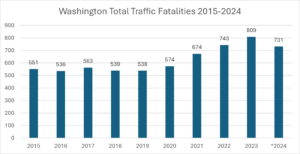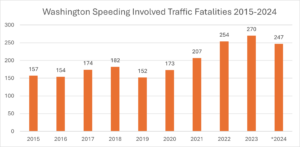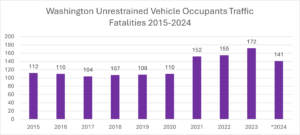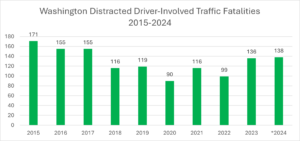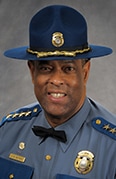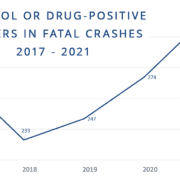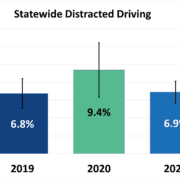Survey shows Support for Reducing Blood Alcohol Concentration (BAC) Limit for Drivers in Washington
For Immediate Release: Dec. 16, 2025
Survey shows Support for Reducing Blood Alcohol Concentration (BAC) Limit for Drivers in Washington
Using a pre-/post-test survey approach, support for a 0.05 BAC limit increased from 54% to 71% of survey respondents, and opposition fell from 34% to 25%, after respondents received information on research behind the policy.
From November 1-8, 2025, DHM Research conducted a large statewide survey of 850 Washington drivers, ages 21 years and older, on behalf of the Washington Traffic Safety Commission (WTSC) and AAA Washington.[i] The purpose of the survey was to understand drinking behaviors, perceptions of the current per se blood alcohol concentration (BAC) limit for driving, and support for lowering the limit to 0.05%.
Survey Findings
Most drivers know the per se BAC limit is 0.08% — and correctly believe impairment starts earlier than 0.08%. Seventy-eight percent (78%) of respondents correctly identified the current legal limit as 0.08%, while nineteen percent (19%) indicated they thought the limit was already 0.05% or lower. Eighty-two percent (82%) of all respondents believed that a person’s driving can be impaired below the current BAC limit of 0.08%. (And, in fact, drivers can be arrested for DUI below this level.)
Most drivers support a 0.05% BAC limit, and opposition drops to 1-in-4 respondents after learning more about it. Before receiving any information on the impacts of a law reducing the BAC limit to 0.05%, respondents indicated fifty-four percent (54%) support for the change, compared to thirty-four percent (34%) opposition. After receiving information about the policy, support increased from fifty-four percent (54%) to seventy-one percent (71%) of survey respondents, and opposition fell from thirty-four percent (34%) to twenty-five percent (25%), with only four percent (4%) indicating that they neither supported nor opposed the change in Washington.
Support for a lower BAC limit increases significantly after hearing facts about impairment’s effects on driving abilities. Respondents were provided factual statements to evaluate and indicate whether this information would increase or decrease their support for the proposed BAC change. The information that they indicated would increase their support of the proposal included the following:
- Researchers have found that countries or states that reduce the BAC limit for driving from 0.08% to 0.05% see an average eleven percent (11%) decrease in traffic fatalities involving alcohol-impaired driving.
- With a BAC level of 0.05-0.079%, a driver (ages 21-34) is nearly five times more likely to be involved in a fatal crash compared to a driver with no alcohol in their system.
- Research has found that driving performance declines between twenty-five percent (25%) and fifty-five percent (55%) for a person with a BAC of 0.05%.
- In states and countries that have reduced their BAC limits, they find that fewer people drive under the influence of alcohol, and the level of alcohol among people who drive is reduced.
- Impairment at 0.05% BAC means that a person’s abilities to drive are reduced in terms of reaction time, visual functioning, ability to shift attention, steering, emergency responses, and coordination.
“This survey shows that Washingtonians care deeply about creating safer roads and highways,” said Mark McKechnie, WTSC’s External Relations Director. “Most drivers 21 and older already know that impairment begins before the per se legal limit of 0.08%. With this understanding, most people think it’s obvious that the limit should be lower.”
Survey Respondents
The survey is a statistically valid sample of Washington drivers over the age of 21. Its 850 respondents represent demographic groups across the state. Respondents reflect the population distribution throughout the state, with twenty-nine percent (29%) residing in King County and twenty percent (20%) residing in Eastern Washington.
Sixty-two percent (62%) were between the ages of 30 and 64 years. Sixty-two percent (62%) identified as White, thirteen percent (13%) as Hispanic/Latino/a/x, and sixteen percent (16%) as other People of Color. Ninety percent (90%) indicated that they drive several times a week or every day.
Fifty-six percent (56%) of respondents indicated they drink alcoholic beverages. Among drinkers, eighty-four percent (84%) said they drink six or fewer standard drinks per week, while fifteen percent (15%) said they drink seven or more per week, on average. Three-quarters of drinkers said that they often or always plan their transportation ahead of time before going out to consume alcohol, and only four percent (4%) said they drive themselves home after consuming three or more alcoholic beverages.
After receiving information about a 0.05 BAC limit for driving, every demographic group voiced majority support for the change, ranging from sixty-five percent (65%) to seventy-eight (78%) support. Opposition from any group was thirty percent or less, including those who ranked highest in opposition: men, those with incomes of $150,000 or higher, and alcohol drinkers.
About WTSC
The Washington Traffic Safety Commission (WTSC) is Washington’s designated highway safety office. WTSC’s mission is to empower and equip people and communities with knowledge, tools, and resources to build a positive traffic safety culture. Partnering with other state and local public agencies, WTSC works to reduce traffic fatalities and serious injuries to zero by 2030. WTSC focuses specifically on behaviors that most often contribute to roadway fatalities and serious injuries, including impairment, excessive speed, distraction, and lack of seat belt use.
The survey report is published on WTSC’s website.
About AAA Washington
Founded in 1904, AAA Washington is a not-for-profit based in Bellevue, Wash. For 120 years, AAA Washington has championed safer mobility, preserving the area’s natural beauty, and showcasing Washington as an unrivaled travel destination. It has long supported communities across the Pacific Northwest, including through its beloved School Safety Patrol program and Batteries to Branches™ battery recycling campaign. More than 1.2 million members across Washington and Northern Idaho turn to AAA Washington for trusted services like automotive, travel, and perks.
________________________
[i] The hybrid phone, online, and text-to-online survey consisted of 850 Washington drivers and took approximately 12 minutes to complete. This is a sufficient sample size to assess opinions generally and to review findings by multiple subgroups including age, gender, race, education level, income, area, and drinking habits. The survey had a confidence interval of 95% and a margin of error of ± 3.4%.
###

